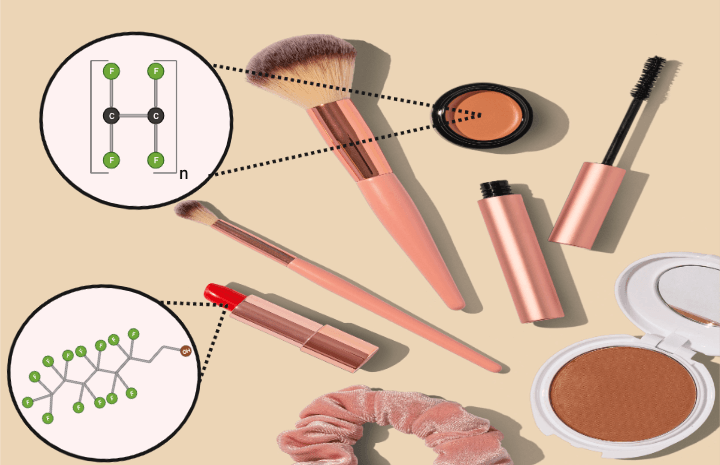
PFAS in Cosmetics: A Hidden Threat to Women's Fertility and Pregnancy
Share
In recent years, the conversation around environmental toxins and their impact on health has intensified. One group of chemicals at the center of this discussion is per- and polyfluoroalkyl substances (PFAS). These "forever chemicals" are found in a wide range of consumer products, including cosmetics. While PFAS have been linked to various health concerns, their impact on fertility and pregnancy is particularly alarming. Understanding how these chemicals infiltrate daily beauty routines and affect reproductive health is crucial for women seeking to conceive and maintain a healthy pregnancy.
Many cosmetic products, including foundations, mascaras, lipsticks, and waterproof makeup, contain PFAS. These chemicals enhance product durability, making them longer-lasting and more resistant to water and sweat. A study published in Environmental Science & Technology found that 52% of tested cosmetics contained high levels of fluorine, an indicator of PFAS presence (Whitehead et al., 2021). However, due to inadequate regulations, PFAS often go undisclosed on ingredient labels, making it difficult for consumers to identify and avoid them.
How PFAS Affect Fertility and Pregnancy
Research indicates that PFAS exposure can disrupt reproductive health in several ways:
1. Hormonal Disruption
PFAS interfere with the endocrine system, affecting estrogen and progesterone levels. These hormones are essential for regulating menstrual cycles, ovulation, and pregnancy maintenance (Kahn et al., 2020). Disruptions in hormonal balance can lead to irregular cycles, anovulation, and increased risk of miscarriage.
2. Reduced Ovarian Reserve and Egg Quality
Studies suggest that PFAS exposure correlates with diminished ovarian reserve, which refers to the number and quality of a woman's eggs. Women with higher PFAS levels in their blood have been found to experience lower anti-Müllerian hormone (AMH) levels, a key indicator of fertility potential (Teng et al., 2022).
3. Increased Risk of Pregnancy Complications
PFAS have been linked to pregnancy complications such as preeclampsia, gestational diabetes, and low birth weight. A study conducted by Braun et al. (2020) found that pregnant women with elevated PFAS exposure had a higher likelihood of developing hypertensive disorders, which can be dangerous for both mother and baby.
4. Interference with Fetal Development
PFAS can cross the placenta and accumulate in fetal tissues, potentially impacting fetal growth and development. Research has shown associations between prenatal PFAS exposure and altered birth weight, immune dysfunction, and later-life metabolic disorders in children (Blake et al., 2021).
How to Reduce PFAS Exposure from Cosmetics
While completely eliminating PFAS exposure is challenging, women can take proactive steps to minimize their risk:
-
Check ingredient lists: Look for terms like "PTFE" or "perfluoro-" in product descriptions.
-
Opt for clean beauty brands: Choose cosmetics from companies committed to transparency and free from PFAS.
-
Use the Environmental Working Group (EWG) database: The EWG provides a database of safer cosmetic products.
-
Reduce use of waterproof and long-wear makeup: These products are more likely to contain PFAS.
PFAS in cosmetics pose a significant risk to women's reproductive health, fertility, and pregnancy outcomes. While awareness and regulation efforts are growing, it is essential for women to take proactive measures in selecting safer beauty products. By making informed choices, women can reduce their exposure to these harmful chemicals and protect their reproductive health.
Take charge of your fertility journey today with PureFertility and embrace the future you deserve, take a look at PureFertility today!References
Blake, B. E., Cope, H. A., Hall, S. M., Keys, R. D., Mahler, B. W., McCord, J., & Strynar, M. J. (2021). Per- and polyfluoroalkyl substances and women’s health: A review of the epidemiological literature. Environmental Research, 195, 110879. https://doi.org/10.1016/j.
envres.2021.110879 Braun, J. M., Eliot, M. N., Papandonatos, G. D., Buckley, J. P., Cecil, K. M., Kalkwarf, H. J., & Chen, A. (2020). Prenatal perfluoroalkyl substance exposure and child adiposity at 8 years of age: The HOME study. Obesity, 28(3), 566-573. https://doi.org/10.1002/oby.
22739 Kahn, L. G., Philippat, C., Nakayama, S. F., Slama, R., & Trasande, L. (2020). Endocrine-disrupting chemicals: Implications for human health. The Lancet Diabetes & Endocrinology, 8(8), 579-590. https://doi.org/10.1016/S2213-
8587(20)30129-7 Teng, C., Lu, Q., Zhao, Y., Zhao, C., & Wang, W. (2022). Association between per- and polyfluoroalkyl substances exposure and ovarian reserve: A systematic review and meta-analysis. Environmental Pollution, 293, 118566. https://doi.org/10.1016/j.
envpol.2022.118566 Whitehead, H. D., Venier, M., Wu, Y., Eastman, E., Urbanik, S., Diamond, M. L., & Scheringer, M. (2021). Fluorinated compounds in North American cosmetics. Environmental Science & Technology Letters, 8(7), 538-544. https://doi.org/10.1021/acs.
estlett.1c0024
